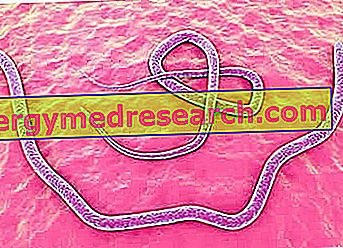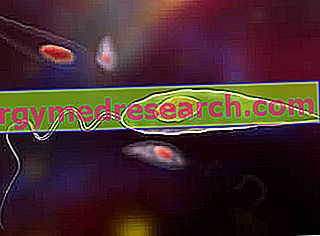Generality
Parasitoses are infections caused by parasites.
Parasites are living beings, single-celled or multicellular, that live at the expense of an organism that hosts them, drawing from it the food necessary for survival, growth and reproduction.

The symptoms of a parasitosis depend on the causative agent. Generally, most parasitosis causes gastrointestinal symptoms.
Only thanks to an accurate diagnosis of the parasite that triggered the parasitosis, it is possible to plan the most appropriate therapy.
What is parasitosis?
Parasitoses are infectious diseases caused or transmitted by parasitic organisms.
Parasites are living beings, single-celled or multicellular, that live at the expense of other organisms (so-called " host " organisms), drawing from them the nutrients they need to survive, grow and reproduce.
Causes
Among the causes of human parasites there are three types of parasites:
- Protozoa
- The helminths
- Ectoparasites
PROTOZOA AND PARASITIC DERIVATIVES
Protozoa are a heterogeneous group of unicellular eukaryotic microorganisms, widespread in almost all types of habitats, from the ground and the deepest sea to freshwater basins.
They are heterotrophic, that is organisms that draw energy and other compounds, feeding on organic substances processed by other organisms.
In nature, there are more than 50, 000 different species of protozoa; microbiologists have established that a good criterion, to distinguish this huge number of protozoan species, is the displacement mechanism.
Depending on the mode of travel, protozoa can be defined:
- Ciliates . The ciliated protozoa perform their movements with hairs (the so-called cilia), located all around the cells.
- Flagellates . The flagellated protozoa move by means of one or more flagella, which are in fact large cilia.

- Amoeboid . The amoeboid protozoa perform their movements, through extroflexions of the plasma membrane, called pseudopods.
- Sporozoa . The protozoan sporozoa lack the appropriate structures for movement and this led them to develop a great capacity to adapt to the environment in which they live.
They are among the main protozoa responsible for parasitosis in humans.
DERIVATIVES AND PARASITICIANS
Visible to the naked eye in their adult stage, helminths are worm- like multicellular organisms that, like parasites, generally live inside the host organism (usually in the intestine).
According to the most recent studies, in nature there are two main groups of helminths, which cause parasitosis in humans:
- The group of flatworms or flatworms . The Trematodes and Cestodes are part of this group of helminths.
- The group of nematodes and cylindrical worms
DERIVING ECTOPARASSITIS AND PARASITOSIS
Human ectoparasites are all those parasitic organisms that live and grow outside the host human being, to be precise on the skin .
The link established by ectoparasites can also be very long, in the order of weeks or even months.
The ability of ectoparasites to stabilize outside the host organism is, generally, due to specific organs or the buccal apparatus (which therefore has a dual function: allowing the bond and withdrawing nutrients from the host).
The ectoparasites of human interest belong to the phylum of the Arthropods and they are: the ticks, the lice, the mites, the mosquitoes and the fleas.
These life forms are carriers (or carriers ) of pathogenic agents, generally bacterial or viral, which are the real culprits of the parasites.
TRANSMISSION MODE
The methods of transmission / diffusion of the parasites are different; one of the most common is direct contact with: contaminated water, contaminated waste, contaminated faecal material, blood from an infected person, contaminated food, etc.
Many ectoparasites transmit the infectious agent, which then triggers the parasitosis, through the apparatus with which they bind to the skin of the host, to steal nourishment or sting it.
The transmission of some parasites can also take place through unprotected sexual intercourse.
RISK FACTORS
Anyone can develop a parasitosis.
However, there are people more at risk than others.
For example, individuals living in tropical or subtropical areas - geographical environments that favor the growth and reproduction of a wide range of parasites - are more endangered.
Furthermore, they are more at risk of parasitosis:
- subjects with a less efficient immune system, as they lack a defensive barrier against the surrounding pathogens;
- people who have the habit of bathing in lake basins, in which parasites of various kinds often lurk;
- individuals who love to surround themselves with cats (pregnant women are particularly endangered);
- finally, all the childcare workers.
Types
To facilitate the reader's consultation of the various existing human parasites, it was decided to divide them according to the type of parasite involved.
Therefore, it follows that:
- Protozoa are the possible responsible for:
- Malaria → causative agent: Plasmodium malariae, from the group of prorozoa sporozoa (NB: human beings often contract malaria through a vector, which is the mosquito).
- Giardiasis → causative agent: Giardia lamblia, from the group of flagellated protozoa.
- Cryptosporidiosis → Cryptosporidium, from the group of protozoa sporozoa.
- Toxoplasmosis → causative agent: Toxoplasmosis gondii, from the group of prorozoa sporozoa.
- Trichomoniasis → causative agent: Trichomonas vaginalis, from the group of flagellated protozoa.
- Amebiasis → causative agent: Entamoeba histolytica, of the group of amoeboid protozoa.
- Amoebic dysentery → causative agent: Entamoeba histolytica, of the group of amoeboid protozoa.
- Human leishmaniasis → causative agent: Leishmania, from the group of flagellated protozoa.
- Chagas disease → causative agent: Trypanosoma cruzi, from the group of flagellated protozoa.
- African trypanosomiasis → causative agent : Trypanosoma, from the group of flagellated protozoa.
- The Platelminti are the possible responsible for:
- Schistosomiasis → causative agent: Schistosoma .
- Swimmer dermatitis → causative agent: Schistosoma .
- Solitary worm → causal agent: Taenia .
- Fasciolosis → causative agent: Fasciola hepatica .
- The Nematodes are the possible responsible for:
- Ascariasi → causal agent: Ascaris .
- Necatoriasi → causal agent: Necatur americanus .
- Trichinosis → causative agent: Trichinella .
- Trichuriasis → causative agent: Trichuris .
- Elephantiasis → causative agent: Wuchereria bancrofti .
- Enterobiasis → causative agent: Enterobius vermicularis .
- The ectoparasites are the possible responsible for:
- Lyme disease or Lyme borreliosis → causative agent: the bacterium Borrelia, transmitted by ticks belonging to the Ixodidae family.
- Rickettsiosi → causative agent: bacteria of the Rickettsial family, transmitted by the ticks belonging to the Ixodidi.
- Tularemia → causative agent: the bacterium Francisella tularensis, transmitted by Ixodidi ticks.
- Ehrlichiosi → causal agent: bacteria of the Rickettesie family, transmitted by Ixodidi ticks.
- Tick-borne meningoencephalitis → causative agent: Flavivirus virus, transmitted by Ixodidi ticks.
Symptoms and Complications
The symptoms of the parasites are extremely variable and depend on the responsible pathogen.
For example:
- giardiasis, amoebiasis, amoebic dysentery, cryptosporidiosis or the solitary worm cause, mainly, gastrointestinal disorders (diarrhea, abdominal cramps, vomiting, nausea and loss of appetite);
- malaria is responsible for fever, chills, sweating, tiredness and decreased appetite;
- toxoplasmosis is a cause of flu-like symptoms;
- Lyme disease causes skin erythema, fever, fatigue, headache, neck stiffness and muscle aches;
- swimmer's dermatitis produces itching and skin erythema; and so on.
Diagnosis
For a correct diagnosis of parasitosis and for identifying the causative agent, it may be useful:
- The stool test . Brings up any presence of parasite eggs.
- Endoscopy or colonoscopy . They foresee the use of a tubular-shaped instrument, equipped with a camera at one end and arranged for its introduction into the mouth or rectum.
The camera is connected to an external monitor, onto which it projects what it views inside the human body.
- Blood tests . They allow the recognition of some parasites, present in the human body.
In addition, in special cases, doctors may also consider it necessary to carry out a nuclear magnetic resonance and / or a CT scan: these diagnostic imaging procedures make it possible to establish whether the parasitosis has caused some type of damage to particular organs or tissues of the human body.
Treatment
The treatment of parasites varies according to the responsible pathogen.
This means that to correctly treat an infectious disease caused by parasites, it is essential to trace back to the precise cause.
For the sake of brevity, in this article we will propose only some treatments of the more classic parasites. For further information, readers can refer to the references that they will find from time to time.
- Malaria: the treatment is pharmacological and involves the administration of chloroquine, quinine sulphate-hydrochloride and / or artemisinin derivatives.
For more information, see the article here.
- Trichomoniasis: treatment is pharmacological and involves the administration of antibiotics.
For more information, see the article here.
- Giardiasis: the treatment is pharmacological and generally consists of the administration of metronidazole and tinidazole.
For more information, see the article here.
- Solitary worm: the treatment involves the use of specific drugs that cause the detachment of the head of the parasite. The elimination of the latter, therefore, occurs through the faeces.
For more information, see the article here.
- Toxoplasmosis: there are no particular treatments, unless it is a serious or long-lasting problem. The therapies consist of the administration of antibiotic drugs and antimalarial drugs.
For more information, see the article here.
- Lyme disease: the therapy consists of the administration of antibiotics (amoxicillin, penicillin or erythromycin), sometimes combined with that of corticosteroids.
For more information, see the article here.
IMPORTANCE OF REHYDRATION
In all those cases of parasitosis with gastrointestinal symptoms, the intake of large quantities of water and mineral salts (rehydration) assumes a fundamental importance, as it prevents dehydration.
The phenomenon of dehydration is a consequence that unites many conditions that induce fluid loss, through episodes of diarrhea, vomiting or excessive sweating.
Prevention
Drink safe and bottled water when traveling, practice safe sex, wash your hands whenever you come into contact with potentially contaminated food, water or faeces, cook the food at the right temperature, sanitize the environment in which you live and avoid doing the bathing in lakes are the main preventive measures that doctors advise to reduce the risk of parasitosis.




